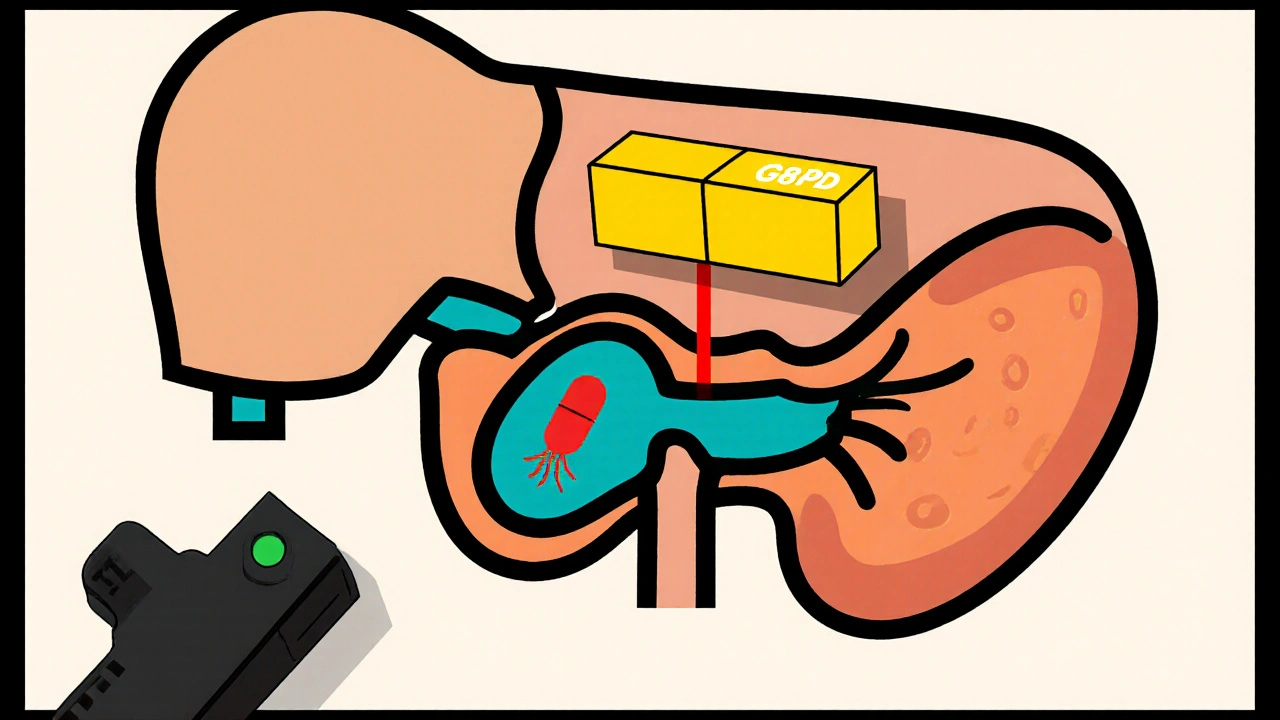When you hear the United Nations talk about ending poverty, ensuring clean water, and guaranteeing good health for all, a tiny malaria drug might not be the first thing that comes to mind. Yet primaquine sits at the intersection of several of those ambitions. By targeting the hidden liver stage of malaria, it helps countries move closer to the health, poverty‑reduction, and partnership goals the SDGs spell out.
What is primaquine?
Primaquine is an 8‑aminoquinoline medication originally developed in the 1940s to eradicate the dormant liver forms (hypnozoites) of Plasmodium vivax and Plasmodium ovale. It is the only drug licensed to provide a radical cure, preventing relapses that can occur weeks or months after the initial infection.
Because relapses sustain transmission cycles in endemic regions, a single dose of primaquine after standard blood‑stage treatment can dramatically cut the number of new malaria cases.
How primaquine works against malaria
Malaria is caused by parasites of the genus Plasmodium a protozoan that infects red blood cells and, for some species, the liver. While Plasmodium vivax is responsible for roughly 30% of global malaria cases and can form dormant liver stages called hypnozoites, Plasmodium falciparum causes the deadliest form of malaria but does not create hypnozoites.
Primaquine’s oxidative action destroys hypnozoites, breaking the cycle of relapse‑driven transmission. In areas where G6PD deficiency a hereditary enzyme deficiency that makes red blood cells vulnerable to oxidative stress is common, dosing must be carefully managed to avoid hemolysis.
The United Nations Sustainable Development Goals at a glance
Sustainable Development Goals a set of 17 global goals adopted in 2015 to guide development efforts through 2030 cover everything from poverty eradication to climate action. Goal 3 - Good Health and Well‑Being - explicitly targets the end of epidemics such as malaria. Yet several other goals intersect with malaria control, creating a network of co‑benefits.

Primaquine’s direct contribution to SDG 3
Goal 3 includes Target 3.3: "End the epidemics of AIDS, tuberculosis, malaria and neglected tropical diseases by 2030". Primaquine helps meet this target in three measurable ways:
- Reduces the incidence of P. vivax malaria, tracked by WHO’s Annual Parasite Index.
- Lowers mortality by preventing severe relapses that can lead to complications, reflected in the malaria mortality rate indicator.
- Supports World Health Organization the UN agency coordinating global health policy and disease surveillance’s goal of eliminating malaria in at least 35 countries by 2030.
Linking primaquine to other SDGs
While SDG 3 is the most obvious fit, the ripple effects of a stronger malaria response touch several additional goals:
| SDG | Target | Primaquine’s role | Key indicator |
|---|---|---|---|
| 3 - Good Health | 3.3 - End malaria epidemics | Radical cure prevents relapses, cuts transmission | Incidence of P. vivax per 1,000 population |
| 1 - No Poverty | 1.5 - Build resilience of the poor | Reducing malaria‑related work loss improves household income | Average days of work lost to malaria per adult |
| 6 - Clean Water & Sanitation | 6.1 - Safe drinking water | Healthier communities can invest in water infrastructure | Proportion of households with safe water |
| 5 - Gender Equality | 5.5 - Women’s participation in health decisions | Maternal malaria prevention empowers women’s health | Maternal mortality ratio from malaria |
| 17 - Partnerships for the Goals | 17.17 - Public‑private partnerships | Collaboration between Global Fund an international financing organization that supports malaria, HIV, and TB programs and national drug‑distribution agencies scales up primaquine access. | Funding allocated to primaquine‑based interventions |
Key challenges to realizing primaquine’s SDG impact
Even with its clear benefits, several practical hurdles slow down adoption:
- G6PD testing gaps: Without reliable point‑of‑care tests, clinicians may avoid primaquine for fear of hemolytic events.
- Regulatory inconsistencies: Some countries still recommend a 14‑day course instead of the WHO‑endorsed single‑dose regimen, leading to poor adherence.
- Supply chain fragility: Limited manufacturing capacity can cause stock‑outs, especially in remote health posts.
- Community awareness: Relapse prevention is a concept many patients never hear, reducing demand for the drug.

Strategies to amplify primaquine’s contribution
Stakeholders can tackle the barriers through a mix of policy, technology, and financing:
- Scale up rapid G6PD diagnostics: Handheld biosensors, like the CareStart G6PD test a point‑of‑care device that delivers results in 2 minutes, enable safe primaquine use in peripheral clinics.
- Adopt WHO’s single‑dose recommendation: Updating national treatment guidelines reduces pill burden and improves adherence.
- Integrate primaquine into mass drug administration (MDA) campaigns: When combined with Artemisinin‑based combination therapy the frontline blood‑stage malaria treatment, MDA can clear both blood parasites and liver hypnozoites in a single visit.
- Leverage financing mechanisms: The Global Fund provides grants to countries for malaria control, including drug procurement can earmark funds specifically for primaquine procurement.
- Community education campaigns: Simple messages about “one dose prevents future fevers” boost acceptance.
Measuring progress - data that matters
Effective monitoring links primaquine deployment to SDG indicators. Health ministries should track:
- Number of primaquine doses administered per year, disaggregated by age and gender.
- Reduction in P. vivax incidence and relapse rates compared to baseline.
- Incidence of adverse events linked to G6PD deficiency, to gauge safety of rollout.
- Economic impact: days of work saved, school attendance improvements, and reduction in hospital costs.
These metrics feed directly into the UN’s reporting framework, allowing countries to showcase how a single drug helps multiple goals.
Future outlook - what’s next for primaquine and the SDGs?
Research pipelines are exploring tafenoquine, a longer‑acting cousin of primaquine that requires only a single dose. If proven safe for all G6PD variants, the drug could simplify logistics further, accelerating progress toward the 2030 targets.
In the meantime, scaling up existing primaquine programs remains a low‑cost, high‑impact lever for governments, donors, and NGOs alike.
Why is primaquine needed if we already have artemisinin drugs?
Artemisinin‑based combination therapy clears the blood stage of malaria but does nothing to the dormant liver forms of P. vivax and P. ovale. Without primaquine, patients can relapse weeks or months later, prolonging transmission cycles.
Can anyone take primaquine safely?
People with normal G6PD enzyme activity can safely take a single dose. Those with G6PD deficiency need a lower dose or a different regimen, which is why rapid testing is crucial before administration.
How does primaquine help achieve SDG 1 (No Poverty)?
Malaria is a major cause of lost workdays and medical expenses for low‑income families. By preventing relapses, primaquine reduces these economic burdens, allowing households to retain income and avoid poverty traps.
What financing options exist for countries to buy primaquine?
The Global Fund, the US President’s Malaria Initiative, and the WHO’s procurement hub offer subsidized pricing and grant mechanisms specifically for malaria elimination, including primaquine supplies.
Is there any risk of drug resistance to primaquine?
So far, resistance to primaquine is rare compared with blood‑stage drugs. Continued surveillance is recommended, especially as usage expands through mass campaigns.

Comments (4)
Paul Luxford
October 26, 2025 AT 15:56
The single dose of primaquine can break the cycle of vivax relapses and keep families from losing a day's wages.
Hershel Lilly
November 7, 2025 AT 10:20
When you look at the data from endemic regions, the drop in the annual parasite index after introducing primaquine is striking. It shows that even a low‑cost drug can shift the epidemiological curve. Scaling up G6PD testing will make that rollout safer and faster.
Carla Smalls
November 19, 2025 AT 04:43
The ripple effects of cutting malaria relapses go far beyond just health statistics.
The farmers who stay healthy can tend their fields without interruption, preserving crop yields.
Children who avoid repeated fevers are more likely to attend school consistently.
Women, especially pregnant mothers, benefit from reduced anemia and safer pregnancies.
Communities experience fewer emergency clinic visits, freeing up limited medical resources.
Economic analyses have shown that each prevented relapse can save dozens of dollars in treatment costs.
When households retain that income, they are less vulnerable to slipping back into poverty.
Moreover, the confidence that comes with reliable malaria control encourages local entrepreneurs to invest.
Public‑private partnerships, such as those with the Global Fund, can channel funds directly to primaquine procurement.
Rapid point‑of‑care G6PD tests empower frontline workers to administer the drug safely.
Education campaigns that explain ‘one dose prevents future fevers’ turn abstract science into everyday knowledge.
Policy makers who adopt WHO’s single‑dose guideline simplify log‑istics and improve adherence.
In the long run, reduced transmission lowers the need for expensive vector control measures.
All these factors align neatly with several Sustainable Development Goals, from good health to no poverty.
So investing in primaquine now builds a foundation for healthier, more resilient societies for years to come.
Monika Pardon
November 30, 2025 AT 23:06
Sure, because nothing says ‘global progress’ like a tiny pill that most people can’t even get due to missing test kits. Yet the big pharma lobby loves to hide that fact while preaching miracles.